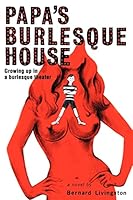Dear Constant Reader,
It’s Wednesday, so how about a book review?
 Papa’s Burlesque House: Growing Up in a Burlesque Theater by Bernard Livingston (1971).
Papa’s Burlesque House: Growing Up in a Burlesque Theater by Bernard Livingston (1971).
This novel, purporting to be an as-told-to story, is more of a thinly veiled autobiography. The point-of-view character grew up in a large Jewish family in Baltimore during the Depression. His weak-willed father, unable to support the family, is pushed into managing a burlesque theatre by a pawn-broker uncle who has acquired the unsavory building.
Family life focuses around the theatre, since the narrator’s father can rarely leave. Shabbos dinner is held with the entire family crammed in the ticket booth. While his parents refuse to enter the theatre, the narrator frequently sneaks backstage and dallies with strippers. He becomes increasingly resentful of his parents’ plans for his life (he’s to become a lawyer — his older brother is going to be a doctor), especially after he learns a few things about his father.
The theatre, called The Burlesk, but known as The Scratch House, is a filthy, seedy dump on the infamous Block. The comics are drunks and the girls are third rate. Some of the activity at the Burlesk is down right unsavory and it will come back to bite the family badly. Not a pretty picture of burlesque, but a realistic one.
 These writings and other creative projects are supported by my Patrons. Thank you so much! To become a Patron, go to my Patreon page.
These writings and other creative projects are supported by my Patrons. Thank you so much! To become a Patron, go to my Patreon page.
It should be noted that one of the ways in which, in the words of the reviewer, ownership of “the Burlesk” comes back to “bite the family badly” is that the so-called “unsavory activity” at the Burlesk begat Chip and Ernie Livingston of 1960s TV fame.
I worked on the Block in the late 70s and remember well the Livingstons of pawn shop fame, as well as many other Block characters like those so vividly described by the author of this well-written, very entertaining burlesque family history. You take a pretty big jump from a mezuza hanging on the ticket booth wall to a bite on the behind, Miss Murray!
Read on for more about the Livingston family and the infamous Clover Theater:
Excerpted from The Baltimore Sun: “A Boyhood On The Block”
August 03, 1992|By Rafael Alvarez | Rafael Alvarez,Staff Writer
“Famous TV siblings Chip and Ernie Douglas of “My Three Sons” are the real-life sons of a Baltimore Block stripper who performed during the Great Depression under the name Marilyn Primrose.
This and other obscure and marvelous facts of Baltimore burlesque fill pages in the personal history of 81-year-old Bernard Livingston, lawyer, author, United Press International photographer, filmmaker, and favorite uncle of Stanley “Chip” Livingston and Barry “Ernie” Livingston.
“You got it,” said Mr. Livingston, in Baltimore this past weekend to screen one of his documentaries in a film festival at the Orpheum Cinema on Thames Street. “Chip and Ernie’s mother was a strip-teaser, and I’m their uncle.”
And like two of his brothers, Mr. Livingston married a stripper from his old man’s burlesque, the Clover Theater on East Baltimore Street known to clients from around the world as the Scratch House.
“Russell Baker told me he saw his first naked woman in the Clover Theater,” said Mr. Livingston, remembering a conversation with the Baltimore-raised columnist for the New York Times. “I guess plenty of guys who grew up here could say the same thing.”
The Clover Theater building, now home to the Club Miami, still stands at 412 E. Baltimore St. Nearby, a pawnshop continues to cast the Livingston name along what is left of the fabled Block.
But the family is scattered, and any connection to the decades when the Livingstons rubbed shoulders with the riff and the raff exists mostly in the memories of Bernard, author of “Papa’s Burlesque House.” ….
“The place that fed them changed the Livingston family forever.
“My older brothers were pretty much grown when my father got the business and they married neighborhood Jewish girls from Park Heights,” said Mr. Livingston of his brothers Harry, a salesman, and the late Dr. Sam Livingston, a well-known Hopkins doctor specializing in epilepsy. “But the three boys who were youngsters when Dad got the burlesque all married strippers. I guess you could say we were ‘exposed’ to these girls,” he said.
The stripper he fell in love with was named Nina Slovik, a nice Polish girl from Eastern Avenue, to whom he was married for about eight years.
“These were wonderful women. . . . , ” he said. “Many of them were poor girls from the hills of Kentucky and Tennessee who took the first job they could get and sent money home to their families.”
When Benjamin Livingston first took over the business, he forbade his family even to visit him on Baltimore Street.
“But he dropped that, and we were down there all the time,” said Mr. Livingston. “If we wanted to see our father, we had to go down to the Clover.”
Soon, he said, the entire family was all but living in the ticket booth to the burlesque theater.
The family spent so much time there, Mr. Livingston said, that his mother hung a mezuza — lines of Scripture directed by Jewish law to be displayed in all homes — on the wall.
“It was essentially our home,” he said. “My mother would bring a kosher Sabbath dinner to my father on Friday night while he was selling tickets to the burlesque show — roast chicken and potatoes, sour pickles, barley soup.”
Thanks for the information about the actual family that inspired the novel. This little missive was only about the story presented within the book, so the reality is interesting to hear.